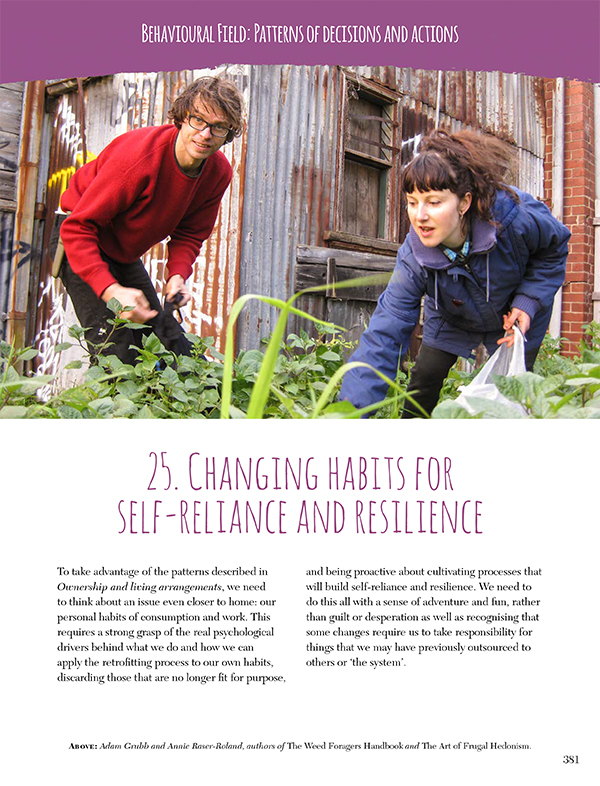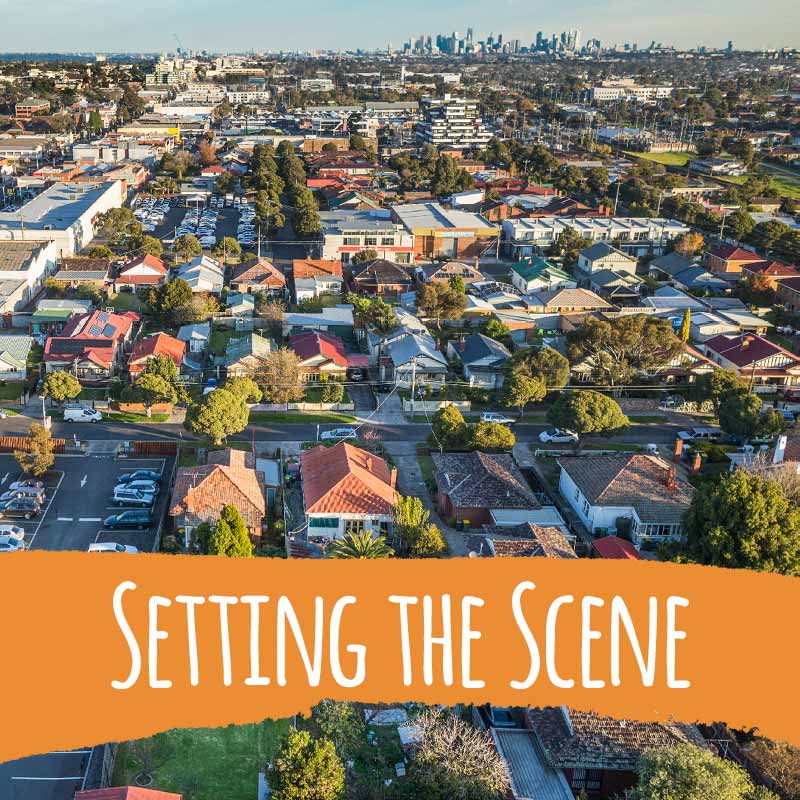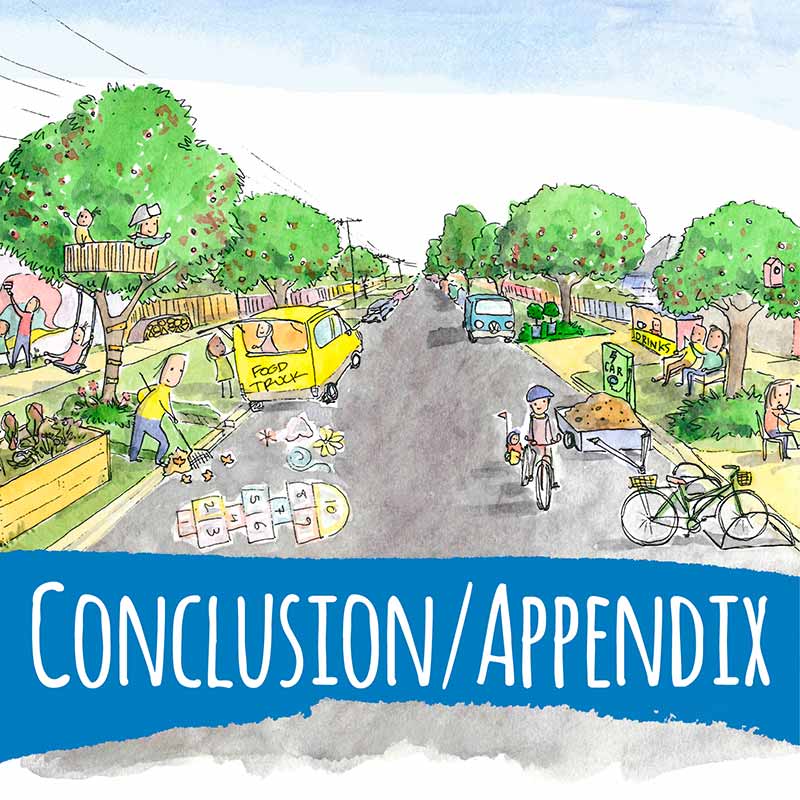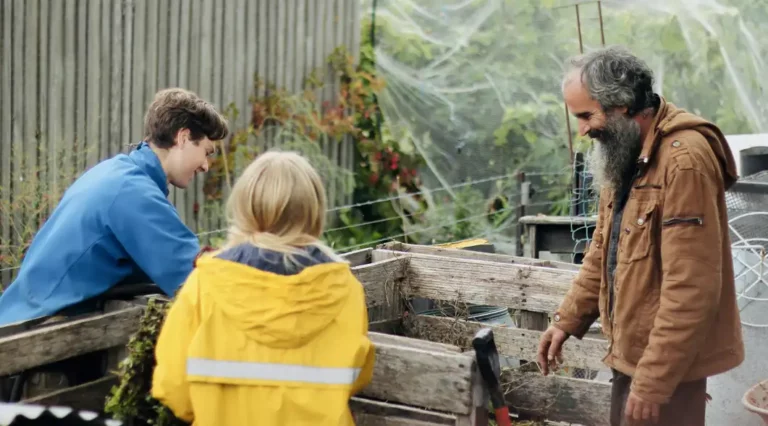Behavioural Field


The Behavioural Field includes everything about how we live in the Built and Biological Fields, from our most unconscious actions through to complex collective organisation that extends from the household out into the wider community and economy.
This section begins with a chapter outlining the Ownership and living arrangements that you could consider before embarking on a retrosuburban journey – my survey of the options covers a rapidly evolving territory of creative solutions! Next we dive into the touchy task of looking at the habits and roles that may be blocking you from finding and following your downshifting path: Changing habits for self-reliance and resilience. Behaviour changes are often critical to avoid some of the perennial issues in our Transport and travel.
Creating your own livelihood in a downsizing world is especially important for younger people planning for the future. And for older people aware of the pointers to uncertain futures, working out what to do with savings and assets often ends up in the too-hard basket, allowing the default usual suspects to determine what happens to our money; the Financial planning and security chapter offers some alternative suggestions. There are no easy answers in either aspect of financing our choices but I provide a review of the options and the pros and cons.
The Sustaining and sustainable diet chapter gets back to basics about aligning our habits and desires with foraged and farmed abundance of season and place. Food and raising children can be one of the make or break issues for most households, thus food naturally segues to Rearing self-reliant and resilient children. As if it couldn’t get any more personal and tender, the Health, disability and aging and Security in hard times chapters address some of the toughest issues downshifters will face.
While some of these topics take us into uncharted territory, Household disaster planning brings us back, with a retrosuburban perspective on widely accepted best practice for all households given the predictions and evidence of climate change. Finally Decision making, interpersonal relations and conflict resolution focuses attention on tricky subjects that many of us recognise as the weak link in creating vibrant and resilient households.
In every chapter I have tried to provide a strategic overview, practical tips and encouragement to collaborate in bringing retrosuburbia to life – and making it the new normal in your household, street and neighbourhood. Even when we can’t change the building, the season or the people we live with, we can always change how we see and experience life for the better.
Behavioural Field Introduction
Focusing on our own behaviour avoids being disempowered by a sense that society seems generally blind and/or mad in relation to the real issues of our time. Or alternatively, it avoids pouring all our energy into attempting to reform some aspect of wider society while our domestic realm drifts along without addressing the critical issues that bring the problems home one way or another.
The taking action at the household level ticks a lot of boxes including:
· immediate rewards to early adopters
· models others can copy, improve, replicate and scale up
· design principles and patterns for those continuing to struggle to reform current systems
· lifeboat backups to provide essential social services as central systems fail slowly or more dramatically.
The following chapters tackle some difficult territory including our living arrangements, personal habits, means of livelihood, finance, diet, children, health, security, decision making and conflict resolution. You might find some of my ideas and solutions challenging while others will just be common sense that you take for granted. Hopefully many will assist and empower you and your household on your evolving retrosuburban journey.
24. Ownership and living arrangements

Reorganising our living arrangements, including how we own and use property, may be the most important aspect of any personal and household strategy to adapt to energy descent futures. Over recent decades, eco-villages and co-housing have been seen as ideal design solutions by many who have sought a simpler way of living in community and in harmony with nature. We can learn a lot from efforts to create these ‘intentional communities’ where the great benefits and substantial difficulties of shared living have been a day-to-day experience. But these intentional communities have had less than resounding success; partly due to continued (debt fuelled) affluence enabling individuals to avoid the difficulties of shared living by doing it alone. Couples, nuclear families and extended family households have not faired much better against these forces fragmenting society into debt bonded and isolated worker/consumers.
Once energy descent processes undermine that affluence, intentional communities will become more popular; no doubt they’ll proliferate to some degree. But the window of opportunity to create ‘greenfields’ eco-villages and co-housing projects may be passing; regulatory gridlock, tight credit and fewer prospective community members with surplus capital make it harder to start from scratch. Most of these communities forming in the near future will more likely be retrofitting existing building stock and may be operating partly outside the planning rules using processes described and advocated in this book.
In this chapter
- The household form and location matrix
- Extended family household
- Hosting volunteers
- Household landlord
- Neighbourhood landlord; create your own community
- Sharing house ownership
- Co-ordinated purchase of adjacent houses
- Relocating to a country town
- Renting in preferred area
- Shared rental household
- Studio living
- Squatting
- Co-housing by retrofit
- Tiny houses
- Network nomads
- Summary
- Vision
Resources
Coming soon
Links
These links are taken directly from the footnotes in the book – we have put them here for easy access when reading the book. It is best if they are viewed in the context of the chapter.
retrosuburbia.com/book/24-2 Hamzelou ‘Living with adult children protects parents against depression’
retrosuburbia.com/book/24-7 Childs ‘In praise of Venie Holmgren’
australianmuseumofsquatting.org Australian Museum of Squatting
murundakacohousing.org.au Murrandaka Co-housing project
retrosuburbia.com/book/24-12 Foss Changes and Choices; A decision tree – life choices for resilience video
25. Changing habits for self-reliance and resilience

To take advantage of the patterns described in Ownership and living arrangements, we need to think about an issue even closer to home: our personal habits of consumption and work. This requires a strong grasp of the real psychological drivers behind what we do and how we can apply the retrofitting process to our own habits, discarding those that are no longer fit for purpose, and being proactive about cultivating processes that will build self-reliance and resilience. We need to do this all with a sense of adventure and fun, rather than guilt or desperation as well as recognising that some changes require us to take responsibility for things that we may have previously outsourced to others or ‘the system’.
In this chapter
- Hair shirts and frugal hedonism
- Home-based work
- Daytime lifestyle and seasonal sleeping patterns
- Managing habits & addictions
- Establishing roles and responsibilities
- Multi-tasking
- Increasing productivity
- Vision
Resources
Coming soon
Links
These links are taken directly from the footnotes in the book – we have put them here for easy access when reading the book. It is best if they are viewed in the context of the chapter.
retrosuburbia.com/book/25-4 Dockery & Bawa ‘Is working from home good work or bad work? Evidence from Australian employees.’
retrosuburbia.com/book/25-5 Ballachey ‘Serotonin, melatonin, and your circadian rhythm’
retrosuburbia.com/book/25-9 Heath ‘How advertisers seduce our subconscious’
26. Transport and Travel

Transporting ourselves and our stuff around consumes more energy than any other activity on the planet. We talk about keeping the wheels of the economy rolling, and making sure they don’t fall off! Almost all that energy is from fossil fuels, and transport is the hardest function to provide using renewable energy. More importantly, 90% of transport worldwide is still powered by oil, the most valuable and rapidly depleting of all our sources of energy.
The peak of conventional oil production was more than a decade ago, and most of the remaining sources of petroleum liquids are of low quality and are generally difficult and expensive to extract. The extraction of shale oil is not currently covering its costs, and the higher-grade petroleum needed for transport requires even more costly refining to make it usable for cars.
Attempting to sustain routine, high-speed and long distant travel by people and transport of goods for a globalised economy is the biggest single mistake that humanity is currently making. The real solutions are to:
· reduce consumption of far-away foods and stuff
· relocalise economies
· travel less at slower speeds for long stays
· re-power the human body for localised mobility.
In this chapter
- Working, shopping and socialising at home
- Using vehicles and travelling time efficiently
- Reducing food (and everything else) miles
- Relocalising daily activities
- Internet substitutions and quandaries
- Transport options
- Traveller lifestyles
- Vision
Resources
Coming soon
Links
These links are taken directly from the footnotes in the book – we have put them here for easy access when reading the book. It is best if they are viewed in the context of the chapter.
retrosuburbia.com/book/26-1a Mantilla ‘Peak oil by any other name is still peak oil’
retrosuburbia.com/book/26-1b Srsrocco ‘The death of the Bakken Field has begun’
retrosuburbia.com/book/26-6 Castle ‘Share and save?’
retrosuburbia.com/book/26-11 Holmgren ‘Why I haven’t been flying (much)’
retrosuburbia.com/book/26-16 ‘Stirling engine’ at Wikipedia
retrosuburbia.com/book/26-17 Sandru ‘DEKA revolt: first hybrid Stirling engine car – powered by anything’
retrosuburbia.com/book/26-18 ‘Homegrown revolution’ Urban Homestead film
retrosuburbia.com/book/26-20a Kris De Decker ‘Wood gas vehicles: firewood in the fuel tank’
retrosuburbia.com/book/26-20b Bartlett ‘Producer Gas and the Australian Motorist… an alternative fuel during the “crisis” of 1939–45’
wwoof.com.au, helpx.net & workway.info volunteering networks
27. Creating your own livelihood

Many people dream about being self-employed or running their own business, and many who try do not succeed. Those that keep at it often do so because of the freedom and autonomy they gain rather than the dollars they earn per hour. Fewer people realise that becoming more self reliant within the household non-monetary economy can be a great stepping-stone to creating a successful livelihood or business.
Livelihoods and ethical small businesses are much more than a way to earn money. They imply commitment, constant improvement and passion for what may start more from a personal interest than a need to pay the bills. Whether driven by passion or necessity, the energy descent future will open pathways to new livelihoods as many current ones expire.
Creating a livelihood is not just about earning money – spending less, doing more for ourselves and restructuring our lives may all be part of out strategy to ensure our needs, and those of our dependents, can be met.
In this chapter
- Disintermediation
- Reducing costs rather than earning more money
- The Great Reskilling
- From employed to self employed
- Future livelihoods
- Keeping track of exchanges
- Vision
Resources
Coming soon
Links
These links are taken directly from the footnotes in the book – we have put them here for easy access when reading the book. It is best if they are viewed in the context of the chapter.
theautomaticearth.com Meijer’s daily ‘Debt rattle’ of global news, focused mostly on the financial system
retrosuburbia.com/book/27-2 Cowgill ‘What is the typical Australian’s income in 2013?’
retrosuburbia.com/book/27-3 Rucker ‘Best time to advertise? When consumers are too tired for anything else’
retrosuburbia.com/book/27-7 Francis ‘Community Supported Agriculture’
retrosuburbia.com/book/27-10 ‘Harvest Program’ at Growing Abundance
retrosuburbia.com/book/27-14 Foss video Changes and Choices; A decision tree – life choices for resilience
retrosuburbia.com/book/27-15 Croft & Rowell ‘An FAQ on the LETS system’
retrosuburbia.com/book/27-17 Graeber ‘On the phenomenon of bullshit jobs’
retrosuburbia.com/book/27-19a Rutger Bregman ‘Why garbagemen should earn more than bankers’
retrosuburbia.com/book/27-19b Meijer (2016) ‘Basic income in the time of crisis’
28. Financial planning and security

For most people, financial planning, or lack of it, tends to be informed by family history and values combined with the ‘group think’ created by media, advertising and mainstream politics. It is difficult for people to consider radically different futures from ‘business as usual’ or behaviours and decisions other than those considered normal. This self-reinforcing conservatism developed in the era of economic growth and stability in Australia and other rich countries since the Second World War but has been in the process of unravelling since the Global Financial Crisis (GFC) of 2008.
In this chapter
- Personal perspective
- Getting out of debt
- Retiring early
- Salvaging savings
- Avoiding social (in)security
- Paying less tax by earning less
- Vision
Resources
Coming soon
Links
These links are taken directly from the footnotes in the book – we have put them here for easy access when reading the book. It is best if they are viewed in the context of the chapter.
retrosuburbia.com/book/28-3 Salerno ‘We are all preppers now’
retrosuburbia.com/book/28-4 Foss ‘The automatic earth primer guide 2017’
retrosuburbia.com/book/28-10 Steve Keen ‘I was wrong on Australian house prices’
organicinvestmentcooperative.com.au Organic Investment Cooperative (ORICoop).
retrosuburbia.com/book/28-24 Brown ‘New G20 rules: Cyprus-style bail-ins to hit depositors AND pensioners’
retrosuburbia.com/book/28-26 Foss ‘Negative interest rates and the war on cash’
retrosuburbia.com/book/28-28 Suchecki ‘A history of gold controls in Australia’
goldstackers.com.au Goldstackers Melbourne
retrosuburbia.com/book/28-35 ‘Ingredients of transition: the great reskilling’
retrosuburbia.com/book/28-38 Holmgren ‘Crash on demand, the discussion so far’
29. Sustaining and sustainable diet

The question of what constitutes a healthy, socially acceptable, sustainable and ethical diet is one of the most vexed and controversial issues for those retrofitting their behaviour for energy descent. The deep cultural, habitual and emotional factors shaping what we eat are not easily redesigned by conscious intent. The solutions often involve trade-offs and are highly context dependent, so what is reasonable in one climate or continent is not on another. Likewise, what is reasonable in the country may be less appropriate in the city – and just because we believe strongly in one perspective, doesn’t mean it would be good if everyone ate that way. Finally, our power to have perfect control over what we eat is limited, even in rich countries. Energy descent will radically reduce our options.
The following patterns distil more than 30 years’ personal experience, observation and teaching about how permaculture principles apply to food harvesting, processing, preserving and eating. What we eat promises to transform the suburban way of life.
In this chapter
- Local in-season food
- Minimally processed whole foods
- Modest consumption of concentrates
- Naturally fermented and traditionally transformed food
- Different diets for different bioregions and people
- Bulk purchasing and reusing packaging
- Wild foods, gleaning and skipping
- Ecological hunting and fishing
- The retrosuburban diet and bioregional food system
- Vision
Resources
Coming soon
Links
These links are taken directly from the footnotes in the book – we have put them here for easy access when reading the book. It is best if they are viewed in the context of the chapter.
retrosuburbia.com/book/29-5 ‘Lamb’s carbon footprint found’
retrosuburbia.com/book/29-14 Sheridan et al ‘Melbourne’s Foodprint: What does it take to feed a city?’
retrosuburbia.com/book/29-20 Griggs ‘The rise and rise of sour dough bread’
retrosuburbia.com/book/29-21 Kresser ‘Raw milk reality: benefits of raw milk’
retrosuburbia.com/reading Holmgren ‘Feeding retrosuburbia: from backyard to the bioregion’
theartistasfamily.blogspot.com.au ‘Artist As Family’ blog
fareshare.net.au Fairshare
retrosuburbia.com/book/29-34 Roberts ‘How does your local food grow?’
30. Rearing self-reliant and resilient children

In Australia, most children are raised in suburbia or suburban-like residential landscapes. In the last 100 years, the importance of the home environment and household relationships in child rearing has declined. Schooling, media and professional childcare have taken over many child rearing roles and responsibilities. This is another case where intermediation occurs as a result of the more or less continuous growth of the fossil fuelled monetary economies. In energy descent futures more services will be provided at home, including child rearing.
In this chapter
- Babies and early childhood
- Children outdoors
- Evaluating risk
- Home education
- Limit media technologies
- Dealing with rebellion
- Initiations and rites of passage
- The demise of extended adolescence
- Vision
Resources
Coming soon
Links
These links are taken directly from the footnotes in the book – we have put them here for easy access when reading the book. It is best if they are viewed in the context of the chapter.
retrosuburbia.com/book/30-7 Holmgren ‘Spring creek community forest’
retrosuburbia.com/book/30-8 Holmgren ‘Permaculture pocket knives’
retrosuburbia.com/book/30-14 Milkwood Permaculture ‘Permaculture apprenticeship: the tiny house that 14yo Zephyr built’
31. Health, disability and aging

Good health is a major factor in wellbeing and when our physical, mental and emotional capabilities are stressed, damaged or declining, we lack resilience, almost by definition. People understand how to maintain good health, at least in principle, but how to recover from illness or injury is more complex. Flexibility in adapting to disability, aging or irresolvable health problems challenges us as mortal beings and consumes an ever escalating amount of resources, technology and intellectual capital. Unsustainable health budgets are one of the signs that fossil fuel powered consumer societies are reaching critical limits.
In this chapter
- Risk and safety
- Retrofitting ourselves
- Looking after yourself
- Household medical capacity
- The medical system
- Alternative therapies
- Drug dependence
- Homebirth
- Aging and disability
- Vision
Resources
Coming soon
Links
These links are taken directly from the footnotes in the book – we have put them here for easy access when reading the book. It is best if they are viewed in the context of the chapter.
healthafteroil.wordpress.com Health After Oil
retrosuburbia.com/book/31-5 Stevenson ‘Lessons from a Homebirth Practice’
retrosuburbia.com/reading ‘Looking after teeth: a personal story’
retrosuburbia.com/book/31-10 ‘Counting the hidden victims of medicine’
retrosuburbia.com/book/31-12 Fisher ‘Tap the placebo effect to unlock your body’s healing powers’
ecosophia.net John Michael Greer
retrosuburbia.com/book/31-15 Sukkar & Smith ‘Panic in Greek pharmacies as hundreds of medicines run short’
retrosuburbia.com/book/31-16 Anderson ‘Drug expiration dates – are they still safe to take?’
retrosuburbia.com/book/31-18 Smith ‘Internal conflict: How we can make friends with harmful bacteria’
retrosuburbia.com/book/31-19 UN News Centre ‘At UN, global leaders commit to act on antimicrobial resistance’
retrosuburbia.com/book/31-20 ‘Fact sheets addressing commonly held concerns regarding vaccination’
retrosuburbia.com/book/31-21 Wilyman ‘Vaccines and autism’
retrosuburbia.com/book/31-22 Scheibner ‘Measles vaccines part ii; benefits of contracting measles’
retrosuburbia.com/book/31-30 Swerissen & Duckett ‘What can we do to help Australians die the way they want to?’
retrosuburbia.com/book/31-31 Terman ‘Fasting: a peaceful way to avoid a prolonged dying with pain and suffering’ video
32. Security in hard times

One of the most common fears about uncertain futures is about personal security, failure of the rule of law and even the risk of complete breakdown of social norms in a ‘dog-eat-dog’ world. That term ‘dog-eat-dog’ is a strange one because dogs generally don’t eat each other, but they do fight over food – when it is abundant! Similarly, the history of human civilisations suggests that human conflict and warfare is most intense when resources are abundant, while human societies are most co-operative when resources are scarce.
In this chapter
- Actively enjoy living in a safe, peaceful country
- Risk, reason and reaction
- Having a sense of humour
- Hedging our bets
- Locks, alarms and arms
- Self defence
- Mobile minimalism
- Network of households
- Secure and networked communities
- Communications technology
- Relationships with law enforcement
- Local government and self-governing communities
- Vision
Resources
Coming soon
Links
These links are taken directly from the footnotes in the book – we have put them here for easy access when reading the book. It is best if they are viewed in the context of the chapter.
retrosuburbia.com/book/32-6a Stuart Hill ‘The Peckham experiment into health ecology: an old study with modern implications’
retrosuburbia.com/book/32-6b Hill ‘Youth creating sustainable, meaningful futures’
retrosuburbia.com/book/32-9 Holmgren ‘Permaculture pocket knives’
retrosuburbia.com/book/32-11a Tatham & Gaffney ‘Food Street: feeding off the kerbside and creating close communities’
retrosuburbia.com/book/32-11b Gaffney et al ‘Residents horrified as Sunshine Coast Council chops, mulches trees in Urban Food Street’
retrosuburbia.com/book/32-12 Holmgren ‘Crash on demand; welcome to the brown tech future’
33. Household disaster planning

In Chapter 11, Retrofitting for bushfire defence, I identified a pattern of small and modest events being easily addressed by centralised systems, while large events lead to failure. For example, many people choosing to have an air conditioner just for the very hottest days increases the chances of a grid failure when they all turn on their appliances. The reliability of the grid, like the reliability of centralised fire services, gives people the false sense of security. Another example is the dependability of the centralised food system, leading to ignorance about the just-in-time logistics1 – only a few days’ worth of food is stored in most communities. The adverse practical impacts of failure of grid power, fire fighters or food are amplified by the psychosocial impacts of losing what was previously reliable. This explains why rich and well-resourced communities and nations seem to suffer so much stress from relatively minor disasters, while poorer but more self-reliant communities in less ‘developed’ nations seem to cope with much bigger disasters.
In this chapter
- General principles and strategies
- Bushfire planning
- Safe houses
- Contributing to community capacity
- Vision
Resources
Coming soon
Links
These links are taken directly from the footnotes in the book – we have put them here for easy access when reading the book. It is best if they are viewed in the context of the chapter.
retrosuburbia.com/book/33-3 Rowe Gympie Get Ready Resilience Toolkit
retrosuburbia.com/book/33-7 CFA ‘Community Fireguard’
retrosuburbia.com/book/33-9 ‘Melliodora bushfire plan’ (1995)
retrosuburbia.com/book/33-10 ‘Melliodora bushfire plan’ (2012)
retrosuburbia.com/book/33-13 ‘A paradise built in hell’ overview
retrosuburbia.com/book/33-15 Albrecht ‘The age of solastalgia’
34. Decision making, interpersonal relations and conflict resolution

The patterns and processes for how to live well together in tougher times – either as a family or a shared household – will present many novel challenges. Most people will draw strongly on their own upbringing and past experience of sharing to get by. Coming to and sticking to agreements while remaining flexible about renegotiations that move a household toward greater resilience will require considerable effort and most importantly self awareness. This is especially so for those who form or head a household, or lead it to greater strength. In Chapter 25, Changing habits for self-reliance and resilience, I explored how establishing roles and responsibilities in a household can enhance the capacity of the household to make effective decisions.
In this chapter
- Benign dictatorship and natural authority
- Household agreements
- Decision-making tools
- Vision
Resources
Coming soon
Links
These links are taken directly from the footnotes in the book – we have put them here for easy access when reading the book. It is best if they are viewed in the context of the chapter.
retrosuburbia.com/reading ‘Phil Bourne on decision making, interpersonal relations and conflict resolution’
retrosuburbia.com/book/34-2 ‘Six thinking hats’
dynamicgroups.com.au Creative Community Governance and Decision Making Resource Kit
earthcare-education.org Earthcare Education Aotearoa





